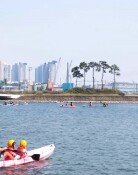How has climate change affected Korea`s retail sector?
How has climate change affected Korea`s retail sector?
Posted November. 26, 2011 05:27,
Dried, frozen or ground foods abound in large discount stores. These processed foods have grown popular as change in water temperature and unpredictable precipitation make it difficult for distributors to predict the supply and demand of farming and fisheries products.
Those in the distribution industry unanimously say "As the weather has become extreme and capricious in recent years, product planning has become difficult and the ability to cope with weather risks has grown important.
○ Detachable products gain popularity
Kang Woo-jin, a senior product planner of the outdoor clothing section at Lotte Department Store, is reeling due to a plunge in sales of outdoor clothing, a huge money earner for the store. Sales in the first eight days of this month fell 10 percent year-on-year.
Abnormal weather is to blame. Considering that duck-down parkas were all sold out in November last year due to the early cold snap, Kang doubled supplies after consultations with major business partners in May.
The average temperature in Seoul over the first 19 days of this month was 13.6 degrees Celsius, up 7.6 degrees from that of last year, however. Therefore, demand for heavy overcoats declined and their sales plunged almost 20 percent.
A dramatic reversal occurred after Sunday, however. With the temperature suddenly plummeting, sales Monday through Friday soared 75 percent from the same period last year. Over the past five days, the average temperature in Seoul was 2.6 degrees Celsius, way lower than last years 7.8 degrees.
Kang said, As predictions of long-term demand are getting difficult due to capricious weather, we`re shifting our production policy from advanced planning to `response production` that flexibly changes supply volume according to weather changes.
With the proportion of response production growing, certain companies that produce goods in developing countries with cheap labor are increasing domestic production.
A staff member at a manufacturer of casual clothes for youths said, The profit rate declined from the time when we conducted planned production in other countries, but response production is more profitable in general as this enables efficient sales.
A source at a womens clothing brand said, We lack major domestic partners because we`ve mostly produced goods in China. We`re searching for factories by paying a premium to quickly produce goods.
Transformer items, or clothing with detachable sleeves and lining, were on display en masse at the womens clothing section of Lotte Department Store in downtown Seoul Friday. AIGLE rain boots, which were a smash hit in summer due to heavy rain, have detachable knee socks made of polyester.
LG Fashions Maestro transformer jackets that debuted in fall are also selling so well, the company will increase production at the end of this month.
Companies that began importing rain boots last year hit the jackpot between June and August, when heavy rain hit Korea. Hunter, a rain boots brand that LG Fashion imports, saw sales grow 3.5 fold from last year.
Choi Gyu-yeong, a deputy manager of the import department at LG, said, Considering Koreas climate is becoming subtropical, we decided to import rain boots.
Luxury brands also reflect climate change in their product lines. Burberry ended its fashion show for this season with snowy and rainy scenes.
Lee Jeong-min, director of the fashion trend consulting company PFIN, said, From this season, luxury brands began full-fledge production of goods that warn of or reflect climate change.
The cosmetics industry is no exception. When cold snaps hit every year, women tend to stay indoors. LG Household & Health Care developed the moisturizing essence Sum A-Time Essence that can be frequently applied.
A researcher for the Amore Pacific Research Institute said, To protect the skin from cold, we have developed a product using seaweed from the Arctic Ocean, where the temperature is extremely low.
○ Soaring sales of dried, frozen and fermented foods
The food sections at large discount and department stores have doubled the share of frozen and dried processed foods over the past two years. This is because crop yields and supplies have grown inconsistent due to unusual weather.
A source at the discount chain E-Mart said, We secure products in the harvest season as much as possible and process the products to put them on shelves as alternate products.
E-Mart`s frozen fruit sales this month rose 23.5 percent year-on-year, with sales of dried fruit growing 26.4 percent and those of dried vegetables gaining 22.7 percent over the same period. Sales of the convenience dried vegetable package, an assortment of dried vegetables, skyrocketed 32-fold.
Sales of tofu and refrigerated fresh fruit juice have also increased. With fish prices soaring due to plummeting catches stemming from change in water temperatures around the Korean Peninsula, consumers are turning to tofu as a source of protein. Tofu sales at discount chain Home Plus as of Friday grew 7 percent from the same period last year.
A bad fruit crop stemming from cold weather damage in spring and the long rainy season in summer caused sales of refrigerated fresh fruit juice to grow 10.7 percent, a huge leap from last years rise of just 0.7 percent.
bright@donga.com







